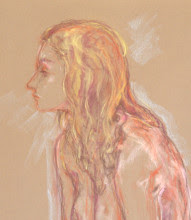[NB. This collaboration has come to an end, but I'm going to leave this up for awhile because it is a good summary of what the work was about. ]
Hanna, Chris
“To see the world in a grain of sand” (William Blake, Auguries of Innocence)
This art collaboration is actively reengaging directly with life. We wanted to remove as many barriers (technology such as the photograph, and psychological façades) as possible between the artist and subject; the subject of each piece is breathing, moving, changing and speaking (a lot).
Up until the beginning of the 20th century, artists had little choice but to center their focus directly on humans and nature, as cameras were not nearly as accessible (not as if technology was never used, and not that any use of technology inherently detracts from the final product). However, since the early 20th century representational artists have increasingly depended on technology such as the camera to play the role of middleman between life and the artist’s final product. This often leaves the product lifeless and unimaginative, diminishing the risk in art – as the intimidating direct engagement with the chaos of life is conveniently avoidable. Without the camera to defer to in decision-making, the artist must bear the responsibility of making a coherent narrative of a three-dimensional evolving human – and sometimes fails.
Artists such as Renoir, Lautrec, and Manet (not to mention countless more) focussed their work for long periods on a single model - such as Suzanne Valadon and Victorine Meurent - both of whom became successful artists in their own right. Renoir, Lautrec and Manet could have chosen from any of the large selection of models available at that time, but made the explicit choice of one particular person to impact their art. However, why they made this choice and the large impact upon their artistic product is ne’er discussed when examining the artist, or his work (philosophically, psychologically, historically, or aesthetically).
We want to continue this Dionysian discourse with life as an undirected question.
skip to main |
skip to sidebar


It's getting better....

Prince Hairy
I have simply wished to base upon a thorough knowledge of tradition the reasoned and independent feeling of my own individuality - Gustave Courbet, 1855
You're an art Mormon! - David Lucas, 2012
Pages
Mature Audiences
I put the "mature audience" warning on for those who are bothered by the dangly bits and lumps and crevices of life, intimacy, and trust - reproductive, mammary, intellectual, emotional, poetic, political, reasoned or unreasoned, what have you. There are lots of other places to find order, cleanliness, and capital "t" Truth, but this isn't really one of them.
A few words of wisdom
Ring the bells that still can ring
Forget your perfect offering
There is a crack in everything
That's how the light gets in.
Forget your perfect offering
There is a crack in everything
That's how the light gets in.
Art
About Me (Chris Brobeck)

- HalifaxCB
- Halifax (well Darkside, really), Nova Scotia, Canada
- The blog name HalifaxCB comes from a handle I used to use on the Global View Forex Forum, which is a great site. If you have come here looking for Forex info, particularly on Kalman filtering, I'm out of the game, but stay and read about art. Or better yet, buy some. That's all I do now.
Current work

It's getting better....
Shorty

Prince Hairy




